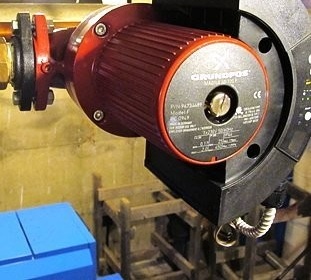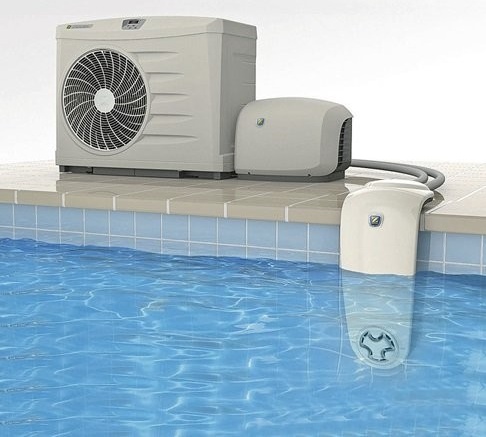Calculation of the circulation pump for heating in examples and formulas
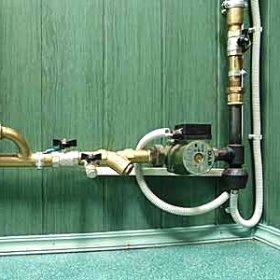
It is impossible to imagine a modern autonomous heating system without a good circulation pump. With the help of this useful device, it is possible to increase the quality of home heating and the efficiency of heating equipment by several times. In order to choose a model that suits a specific system from the many manufacturers' offers, it is necessary to perform the correct calculation of the pump for heating, and also take into account a number of important practical nuances.
Content
Why do I need a pump in the heating system?
Most residents of the upper floors in apartment buildings are familiar with the phenomenon of cold batteries. This is the result of the lack in the system of pressure necessary for its normal operation. The coolant moves through the pipes slowly and cools down on the lower floors. Owners of a private house may also face the same situation: at the farthest point of the heating system, pipes and radiators too cold. Effectively solve the problem will help the circulation pump. note that natural circulation heating systems coolants can be quite effective in small private homes, but even then it makes sense to think about forced circulation, since with the correct system setup this will reduce the overall heating costs.
Simplistically, such a pump is a motor with a rotor, which is immersed in the coolant. The rotor rotates, causing water or other heated fluid to move through the system at a given speed, creating the necessary pressure. The pump can operate in various modes. For example, setting the device to maximum, you can quickly warm up a house that has cooled down in the absence of the owners. Then restore settings that allow you to get the greatest amount of heat at minimum cost. Distinguish models of circulation pumps with a "dry" and "wet" rotor. In the first case, the pump rotor is only partially immersed in the liquid, and in the second case, completely. Wet rotor pumps produce less noise during operation.
How to calculate pump parameters?
A properly selected water pump for heating should solve two problems:
- create a pressure in the system that can overcome the hydraulic resistance of its individual elements;
- to provide sufficient heat to move through the system.
Based on this, when choosing a circulation pump, the building's need for thermal energy should be calculated, as well as the total hydraulic resistance of the entire heating system. Without these two indicators, it is simply impossible to choose a suitable pump.
Useful information about choosing a circulation pump is provided in the following video:
Pump Performance Calculations
The pump capacity, which is usually designated as Q in the calculation formulas, reflects the amount of heat that can be transferred per unit of time. The formula for the calculations is as follows:
Q = 0.86R / TF-TR, where:
- Q - volumetric flow, cubic m / h;
- R is the required thermal power for the room, kW;
- TF - temperature at the supply to the system, degrees Celsius;
- TR - temperature at the exit from the system, degrees Celsius.
The room's heat demand (R) is calculated depending on the conditions. In Europe, it is customary to calculate this indicator based on the standard:
- 100 W / sq. m area of a small private house in which no more than two apartments;
- 70 W / sq. m area of an apartment building.
If the calculations are carried out for buildings with low thermal insulation, the value of the indicator should be increased. For calculations on premises at the factory, as well as on buildings with a very high degree of thermal insulation, it is recommended to use an indicator in the range of 30-50 kW / sq. m
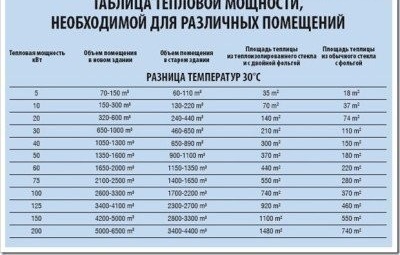
Using this table, you can more accurately calculate the need for thermal energy for rooms for various purposes and with different levels of thermal insulation
Calculation of the hydraulic resistance of the system
The next important indicator is the hydraulic resistance, which will need to be overcome by the circulation pump. To do this, calculate the suction height of the pump. Usually this indicator is designated as "H". You can use the following formula:
H = 1.3 * (R1L1 + R2L2 + Z1 + Z2 + .... + ZN) / 10000, where
- R1, R2 - pressure loss at the supply and return, Pa / m;
- L1, L2 - line length of the supply and return piping, m;
- Z1, Z2 ... ..ZN - resistance of individual elements of the heating system, Pa.
To determine R1 and R2, use the table below:
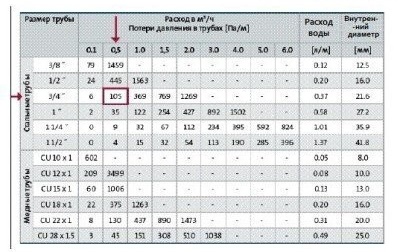
This table provides additional data for a more accurate calculation of the hydraulic resistance that occurs in the heating system of a private house
The hydraulic resistance of individual elements and components of the heating system is usually indicated in the accompanying technical documentation. If for some reason such documentation is missing, you can use the approximate data:
- boiler - 1000-2000 Pa;
- mixer - 2000-4000 Pa;
- thermostatic valve - 5000-10000 Pa;
- heat meter - 1000-15000 Pa.
For other parts of the heating system, see the data in this table:

If the technical documentation is lost for some reason, you can calculate the hydraulic resistance of individual elements of the heating system using the data in this table
Number of speeds of the circulation pump
Most modern models of circulation pumps are equipped with the ability to adjust the speed of the device. Most often, these are three-speed models with which you can adjust the amount of heat entering the room. So, with a sharp cooling, the pump speed is increased, and in case of warming, it is reduced so that the air temperature in the rooms remains comfortable for living.
To switch speeds there is a special lever located on the device. Very popular models of circulation pumps, equipped with a system for automatically controlling the speed of the device depending on changes in outdoor temperature.
It should be noted that this is only one of the options for this type of calculation. Some manufacturers use a slightly different calculation method when selecting a pump. You can ask to perform all the calculations of a qualified specialist, telling him the details of the device for a specific heating system and describing the conditions of its operation. Usually, the maximum load indicators at which the system will work are calculated.In real conditions, the load on the equipment will be lower, so you can safely purchase a circulation pump, the characteristics of which are slightly lower than the calculated indicators. The purchase of a more powerful pump is not advisable, since this will lead to unnecessary costs, but the system will not improve.
After all the necessary data have been obtained, the pressure-flow characteristics of each model should be studied, taking into account the different operating speeds. These characteristics can be presented in graph form. Below is an example of such a graph, which also shows the calculated characteristics of the device.
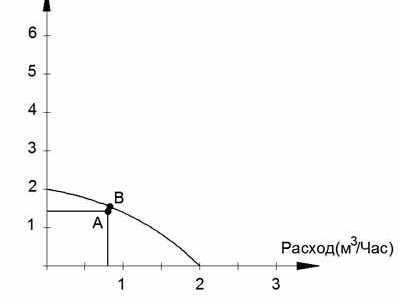
Using this graph, you can choose a suitable model of a circulation pump for heating according to indicators calculated for the system of a particular private house
Point A corresponds to the necessary indicators, and point B indicates the actual data of a particular pump model, as close as possible to theoretical calculations. The smaller the distance between points A and B, the better the pump model is suitable for specific operating conditions.
A few important points
As noted above, circulating pumps are distinguished with a “dry” and “wet” rotor, as well as with an automatic or manual speed control system. Experts recommend the use of pumps whose rotor is completely submerged in water, not only because of the reduced noise level, but also because such models cope with the load more successfully. The pump is installed in such a way that the rotor shaft is horizontal. Read more about installation here.
In the manufacture of high-quality models, durable steel is used, as well as a ceramic shaft and bearings. The life of such a device is at least 20 years. You should not choose a pump with a cast-iron casing for a hot water supply system, since under such conditions it will quickly collapse. Preference should be given to stainless steel, brass or bronze.
If noise occurs during operation of the pump in the system, this does not always indicate a breakdown. Often the cause of this phenomenon is the air remaining in the system after startup. Before starting the system, bleed air through special valves. After the system has worked for several minutes, you need to repeat this procedure, and then adjust the pump.
If the start is made using a pump with manual adjustment, you must first set the device to the maximum operating speed, in adjustable models, when starting the heating system, you just need to turn off the lock.
